Auxiliary verb meaning in Hindi
सहायक क्रिया किसे कहते है?
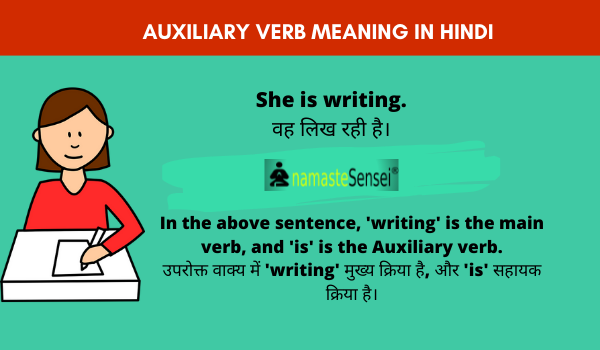
Auxiliary Verb Meaning In Hindi
- The verb which helps the principal verb to complete the meaning of the sentence is called an auxiliary verb. They are also called helping verbs.
वह क्रिया जो मुख्य क्रिया को वाक्य के अर्थ को पूरा करने में मदद करती है, सहायक क्रिया कहलाती है।
Example- उदाहरण
| She is writing. वह लिख रही है। In the above sentence, ‘writing‘ is the main verb, and ‘is‘ is the Auxiliary verb. उपरोक्त वाक्य में ‘writing‘ मुख्य क्रिया है, और ‘is‘ सहायक क्रिया है। |
| They have completed the task. उन्होंने कार्य पूरा कर लिया है। In the above sentence, ‘completed‘ is the main verb, and ‘have‘ is the Auxiliary verb. उपरोक्त वाक्य में ‘completed‘ मुख्य क्रिया है, और ‘have‘ सहायक क्रिया है। |
इससे पहले कि आप और पढ़ें, यह एक अच्छा विचार हो सकता है की मुख्य क्रिया(main verb) के बारे में पहले जान ले।
क्रिया और उसके प्रकार। (Verbs and its types)
- In brief, Main verbs are the most essential verbs in a sentence. They can describe actions or states, or they can be used to link a subject to a description.
संक्षेप में, मुख्य क्रिया एक वाक्य में सबसे महत्वपूर्ण क्रिया है। वे क्रियाओं या अवस्थाओं का वर्णन कर सकते हैं, या उनका उपयोग किसी विषय को विवरण से जोड़ने के लिए किया जा सकता है।
Example- उदाहरण
| I play tennis every wednesday evening. मैं हर बुधवार शाम टेनिस खेलता हूं। In the above sentence, ‘play‘ is the main verb that describes an action. उपरोक्त वाक्य में, ‘खेलना‘ मुख्य क्रिया है जो एक क्रिया का वर्णन करती है। |
- Auxiliary verbs are used very frequently to form different tenses.
विभिन्न काल बनाने के लिए सहायक क्रियाओं का बहुत बार उपयोग किया जाता है।
Types of Auxiliary verbs in Hindi
सहायक क्रिया के प्रकार
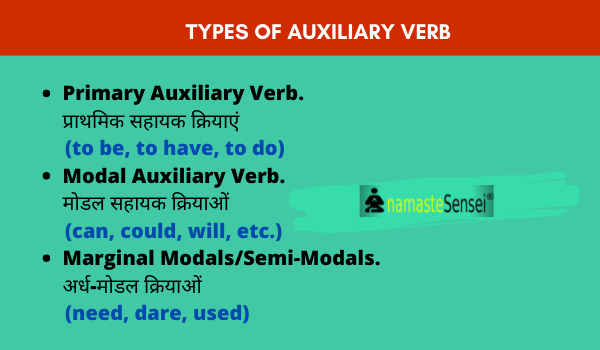
- We can classify Auxiliary Verbs into Primary Auxiliary Verbs and Modal Auxiliary Verbs.
हम सहायक क्रियाओं को प्राथमिक सहायक क्रियाओं और मोडल सहायक क्रियाओं में वर्गीकृत कर सकते हैं। - There is also one other type of modal which we call Marginal modal or semi-modal.
एक अन्य प्रकार के मोडल भी हैं जिन्हें हम Marginal modal या semi-modal कहते हैं।
-
Primary Auxiliary Verb in hindi
प्राथमिक सहायक क्रिया
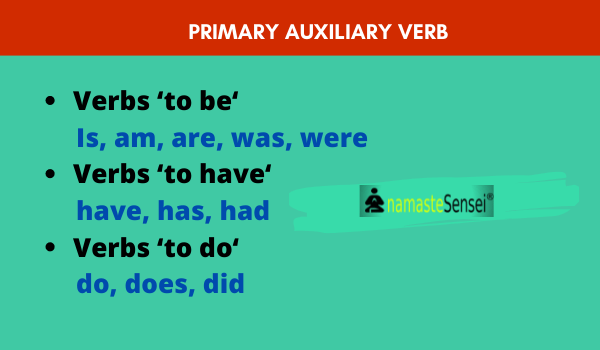
Primary auxiliary verbs are classified into three parts:
प्राथमिक सहायक क्रियाओं को तीन भागों में वर्गीकृत किया गया है:
- Verbs ‘to be‘
Is, am, are, was, were - Verbs ‘to have‘
have, has, had - Verbs ‘to do‘
do, does, did
Primary auxiliary verb ‘to be’ – (Is/ Am/ Are/ Was/ Were)
प्राथमिक सहायक क्रिया
- Is/ Am/ Are, all three verbs are used in Present tense, and Was/ Were is used in Past tense.
Is/ Am/ Are, तीनों verbs का प्रयोग Present tense में तथा Was/ Were का प्रयोग Past tense में होता है। - ‘Is‘ is used in Present Tense with a singular number, third-person ‘Subject’.
Is का प्रयोग वर्तमान काल में singular number, third person ‘Subject’ के साथ होता है।
Example- उदाहरण
|
He is a boy. In the above sentence. ‘He’ is a Third-person, ‘subject’ and ‘He’ is singular. ‘Is’ is used along with ‘He’ |
- ‘Am‘ is used along with ‘I’.
‘Am‘ का प्रयोग ‘I’ के साथ किया जाता है।
Example- उदाहरण
|
I am a man. In the above sentence. ‘Am‘ is used along with ‘I’. |
- Are, Were is used with a plural subject.
Are, Were का प्रयोग बहुवचन विषय के साथ होता है।
Example- उदाहरण
| These shirts are not of my size. ये कमीजें मेरे साइज की नहीं हैं। In the above sentence, ‘These‘ is a plural subject. उपरोक्त वाक्य में ‘These‘ एक बहुवचन विषय है। |
| They were partners. वे भागीदार थे। In the above sentence ‘They’ is a plural subject. उपरोक्त वाक्य में ‘They‘ एक बहुवचन विषय है। |
Primary auxiliary verb ‘to have’ – (Has/ have/ had)
- (Has/ Have/ Had) is used to show possession, and ownership of something.
(Has/ Have/ Had) का प्रयोग किसी वस्तु पर मालिकाना हक, स्वामित्व दिखाने के लिए किया जाता है।
Example- उदाहरण
- I have a car.
मेरे पास एक कार है। - He has a book.
उसके पास एक किताब है। - He had a beautiful house.
उसका एक सुंदर घर था। - I have got a car.
मुझे एक गाड़ी मिली है।
- Has/ Have/ Had also expresses the urgency of the work, the compulsion to do it.
Has/ Have/ Had का प्रयोग कार्य की अनिवार्यता, करने की बाध्यता को भी व्यक्त करता है।
Example- उदाहरण
- He has to complete this work today.
उसे आज यह काम पूरा करना है। - I have to go to Jaipur tomorrow.
मुझे कल जयपुर जाना है। - He had to suffer the loss.
उसे नुकसान उठाना पड़ा।
Primary auxiliary verb ‘to do’ – (do/ does/ did)
- Do, Does, and Did, are used in affirmative sentences to express the following situations.
Do, Does, Did, का प्रयोग सकारात्मक वाक्यों में निम्न स्थितियों को व्यक्त करता है।
Example- उदाहरण
- I do go to her.
मैं उसके पास जाता तो हूं। - She does come here.
वह यहाँ आती तो है। - He did come yesterday.
वह कल आया तो था। - He does read.
वह पढ़ता तो है। - She does take medicines daily.
वह रोजाना दवाएं लेती तो हैं। - She did take medicines daily.
वह रोजाना दवाएं लेती तो थीं।
- In the following sentences do, does, and did are used for emphasis.
निम्न वाक्यों में do, does, did का प्रयोग emphasis हेतु किया जाता है।
| Have a cup of tea. एक कप चाय पीओ। |
Do have a cup of tea. एक कप चाय जरूर लें। |
| Have a seat, please. कृपया सीट ग्रहण करें। |
Do have a seat, please. कृपया सीट जरूर ग्रहण करें। |
| Write to me. मुझे लिखें। |
Do write to me. मुझे जरूर लिखें। |
The use of ‘Do’ in the above sentence does not make the sentence interrogative rather it shows more politeness to the speaker.
उपरोक्त वाक्य में Do का प्रयोग वाक्यों को interrogative नहीं बनाता है बल्कि यह वक्ता कि अधिक विनम्रता प्रदर्शित करता है।
आप प्राथमिक सहायक क्रिया को और विस्तार से जानने के लिए साथ में दिए गए लिंक को पढ़ सकते है
जरूर पढ़े – Primary Auxiliary Verb (विस्तार से)
-
MODAL auxiliary verb meaning in Hindi
मोडल सहायक क्रिया
Modal Auxiliary Verb In Hindi
- Modal Auxiliary Verb expresses the state of the verb.
मोडल सहायक क्रिया, क्रिया की स्थिति/ भाव को व्यक्त करती है।
-
Can, could, will, would, shall, should, must, may, and might are known as modal auxiliary verbs.
Can, could, will, would, shall, should, must, may, and might मोडल सहायक क्रिया के रूप में जाना जाता है।
Examples of Modal Auxiliary Verb in Hindi
मोडल सहायक क्रिया के उदाहरण
| Modal Auxiliary Verb | Example – उदाहरण |
| Can | I can solve this puzzle. मैं इस पहेली को सुलझा सकता हूँ। |
| Could | Could you get another job? क्या तुम्हें दूसरी नौकरी मिल सकती है? |
| Will | I will pay you on Monday. मैं तुम्हें सोमवार को भुगतान करूँगा। |
| Would | I would rather rest now. मैं अब आराम करना पसंद करूँगा। |
| Shall | I shall go to market tomorrow. मैं कल बाज़ार जाऊँगा। |
| Should | You should take care of your health. तुम्हें अपने स्वास्थ्य का ध्यान रखना चाहिए। |
| Must | Visitors must not feed the animals आगंतुकों को जानवरों को नहीं खिलाना चाहिए। |
| May | You may borrow one book at a time. आप एक किताब एक समय में उधार ले सकते हैं। |
| Might | He said that it might rain that day. उसने कहा कि उस दिन बारिश हो सकती है। |
Features of Modal Auxiliary Verb in Hindi
मोडल सहायक क्रिया की विशेषताएं
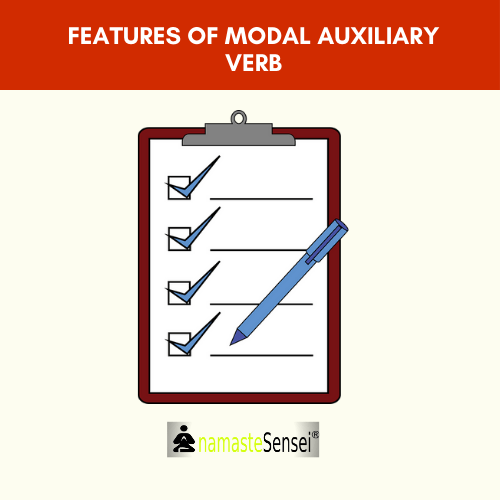
- Modals पर कर्ता के Number; singular या plural होने, या कर्ता के person (first, second, third) person का कोई प्रभाव नहीं पड़ता।
Example- उदाहरण
- I can do it.
मैं यह कर सकता हूं। - They can do it.
वे इसे कर सकते हैं। - He can do it.
वह यह कर सकता है। - You can do it.
आप यह कर सकते हैं।
उपरोक्त वाक्य में कर्ता (Subject) चाहे singular है या plural, first person है या second or third person, modal ‘can’ का रूट अपरिवर्तित रहता है जबकि अन्य helping verb (is, are, am, etc.) कर्ता number एवं person के अनुसार अलग-अलग लगती है।
- Always the first form of verb is used along with modals.
हमेशा क्रिया के पहले रूप का प्रयोग क्रिया के साथ किया जाता है।
| He might win the first prize. वह पहला पुरस्कार जीत सकता है। ‘Win is the first form of the verb. Might is the modal auxiliary verb used along with it. ‘Win’ क्रिया का पहला रूप है। Might इसके साथ प्रयोग की जाने वाली मोडल सहायक क्रिया है। |
जरूर पढ़े – Use of Modals in Hindi – मोडल का उपयोग
-
Semi Modals/ Marginal Auxiliary verb meaning in Hindi
सेमी मोडल
- Some modals like need, dare, used can also be used as main verbs, so they are called marginal modals or semi-modals, or marginal auxiliary verbs.
कुछ modals जैसे need, dare, used का प्रयोग main verbs की तरह भी हो सकता है अत: उन्हें marginal modals या semi-modals या marginal auxiliary verbs कहा जाता है।
| Marginal Auxiliary Verb | Example – उदाहरण |
| Need | He need not talk to her. उसे उससे बात करने की जरूरत नहीं है। |
| Used | He used to drink daily. वह रोज शराब पीता था। |
| Dare | I dare say it will rain. मैं यह कहने की हिम्मत करता हूं कि बारिश होगी। |
जरूर पढ़े – Semi Modal Auxiliary Verb (विस्तार से)
Auxiliary Verb In Hindi PDF
बधाई हो, आपने Auxiliary verb meaning in Hindi का पूरा लेख पढ़ा। यदि आपके कोई संदेह या प्रश्न हैं, तो बेझिझक नीचे टिप्पणी करें। हम जितनी जल्दी हो सकेगा संपर्क करेंगे।
अधिक लेख:
Any topic you want us to cover. Let us know.
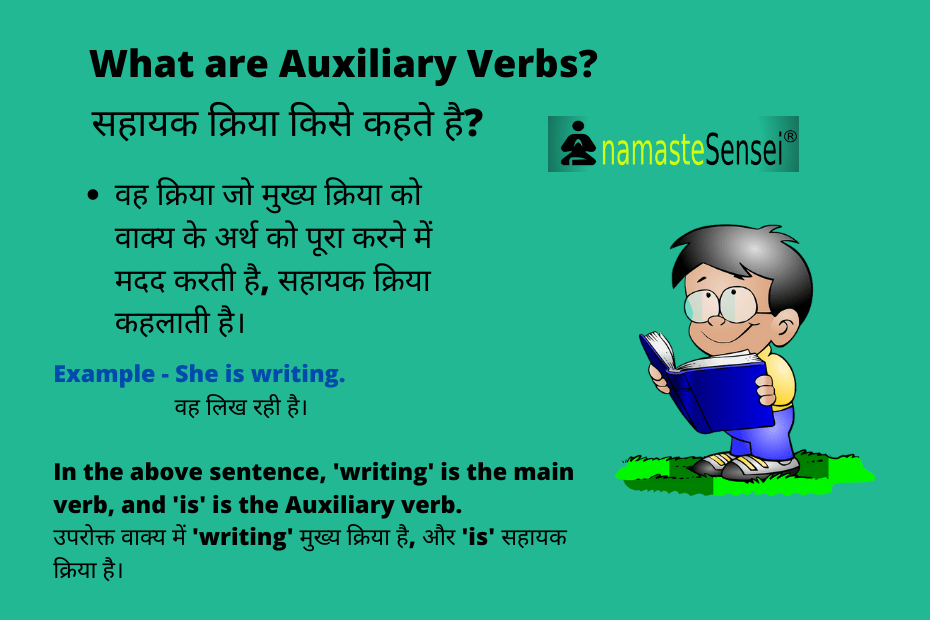
thanks a lot.
Keep Learning 🙂